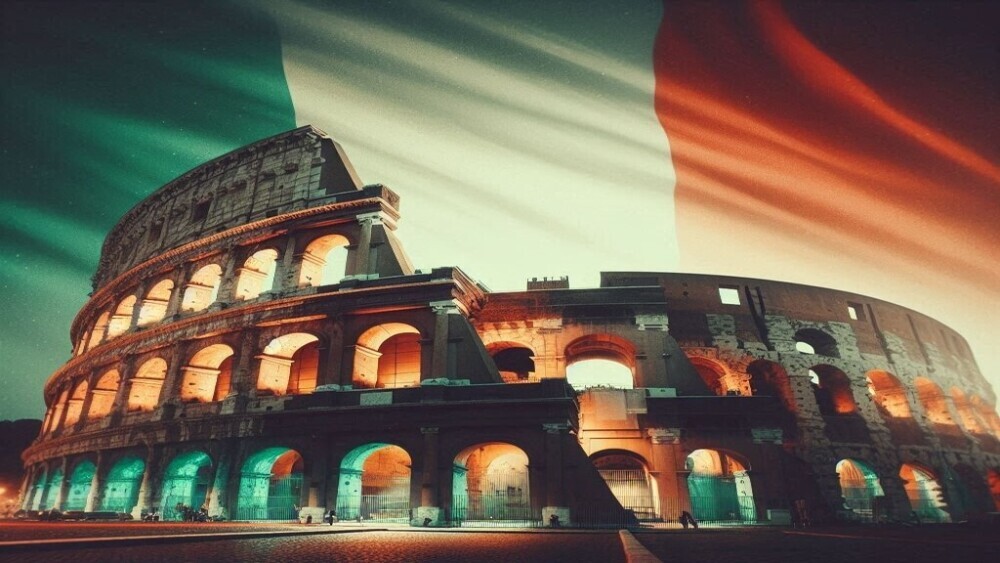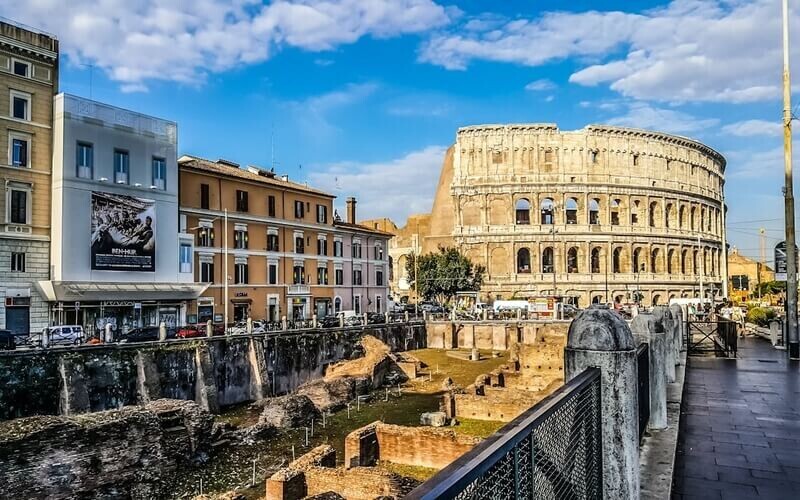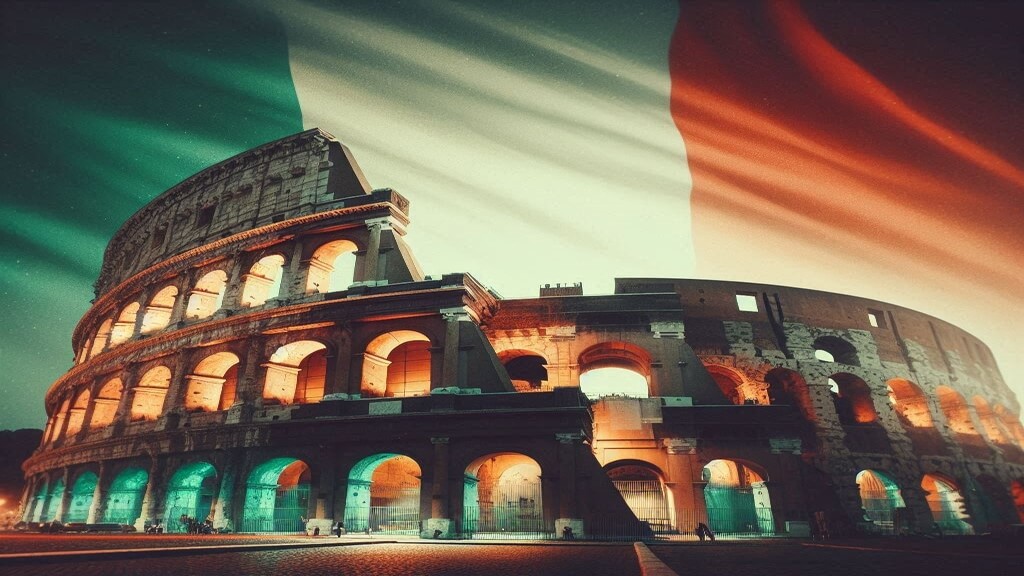
Italy is more than just a country; it’s a living museum, where every corner is filled with history, art, culture, and natural beauty. Whether you’re standing in awe of Rome’s ancient ruins, cruising through Venice’s canals, or relaxing on the Amalfi Coast, Italy is a destination that offers something for everyone. With its world-famous food, centuries-old architecture, and stunning landscapes, Italy promises unforgettable experiences no matter which city or region you visit.
This guide will take you through ten of Italy’s most iconic places, each offering a unique window into Italian life, culture, and history. Get ready to explore ancient cities, art-filled towns, and picturesque landscapes.
1) Rome: The Eternal City

Rome is a city that encapsulates the essence of Italy’s rich historical heritage and modern vibrancy. As the capital of the ancient Roman Empire and the seat of the Catholic Church, Rome’s influence on the world is unmatched. Walking through Rome feels like walking through time; ruins from 2,000 years ago sit alongside Renaissance palaces and Baroque fountains, offering endless exploration.
Must-See Landmarks:
- The Colosseum: As the largest amphitheater ever built, the Colosseum is one of Rome’s most iconic symbols. Once hosting gladiatorial contests and public spectacles, today it’s a testament to the grandeur of Roman engineering and culture.
- The Roman Forum: This ancient plaza was the center of Roman public life, where religious, political, and social activities took place. Explore the ruins of temples, basilicas, and the Curia, where the Roman Senate once met.
- The Pantheon: Famous for its massive dome and oculus, the Pantheon is a marvel of ancient engineering. Originally built as a temple to all gods, today it serves as a Catholic church and the resting place of notable Italians like the artist Raphael.
- Vatican City: The smallest independent state in the world and home to the Pope, the Vatican is a treasure trove of art and architecture. Visit St. Peter’s Basilica, the Vatican Museums, and marvel at Michelangelo’s frescoes in the Sistine Chapel.
What to Experience: Wander through the charming streets of Trastevere, a neighborhood known for its narrow alleys, quaint cafes, and lively piazzas. Visit Piazza Navona, one of the most beautiful squares in the city, and don’t forget to toss a coin into the Trevi Fountain to ensure your return to Rome.
2) Florence: The Cradle of the Renaissance

(Photo by MustangJoe on Pixabay)
Florence, the capital of the Tuscany region, is often regarded as the birthplace of the Renaissance. It’s here that artists like Michelangelo, Leonardo da Vinci, and Botticelli created works that still inspire awe today. Florence’s artistic and architectural treasures make it a must-visit destination for anyone passionate about culture and history.
Must-See Landmarks:
- The Duomo (Cattedrale di Santa Maria del Fiore): Florence’s cathedral is an architectural masterpiece, crowned by Brunelleschi’s dome, which remains one of the largest brick domes in the world. Climb the 463 steps to the top for breathtaking views of the city.
- The Uffizi Gallery: One of the most famous art museums in the world, the Uffizi houses masterpieces from the likes of Leonardo da Vinci, Botticelli, and Raphael. Don’t miss Botticelli’s The Birth of Venus or da Vinci’s Annunciation.
- Ponte Vecchio: This medieval stone bridge, famous for its jewelry shops, offers stunning views of the Arno River. It’s one of the few bridges in Florence to survive World War II.
What to Experience: Take a stroll through the Boboli Gardens, explore the Palazzo Pitti, or enjoy a sunset from Piazzale Michelangelo, where you can soak in a panoramic view of Florence’s skyline.
3) Venice: The Floating City

Venice is a city unlike any other. Built on a network of islands separated by canals, Venice is a place where boats replace cars and Gothic palaces rise from the water’s edge. Known for its romance, beauty, and artistic heritage, Venice is an essential stop for any traveler in Italy.
Must-See Landmarks:
- St. Mark’s Basilica: One of Venice’s most iconic structures, this cathedral is famous for its gilded mosaics and Byzantine architecture. The Piazza San Marco, with its cafes and shops, is the social heart of Venice.
- The Grand Canal: The main artery of Venice, this waterway is lined with centuries-old palaces. A vaporetto (water bus) ride offers one of the best ways to see Venice.
- Rialto Bridge: One of Venice’s oldest and most famous bridges, it offers stunning views of the Grand Canal and is a bustling marketplace for local vendors.
What to Experience: Take a gondola ride through Venice’s quieter canals, visit the glass factories of Murano, or explore the lace-making island of Burano, famous for its colorful houses.
4) Amalfi Coast: Italy’s Coastal Gem

(Photo by Michael Block on Pexels)
The Amalfi Coast, a UNESCO World Heritage Site, is one of the most beautiful stretches of coastline in the world. With its dramatic cliffs, azure waters, and charming towns, it’s a dream destination for those seeking natural beauty and relaxation.
Must-See Towns:
- Positano: Known for its pastel-colored houses cascading down to the sea, Positano is one of the most photographed towns on the Amalfi Coast. Stroll through its narrow streets, relax on its beaches, and indulge in fresh seafood.
- Amalfi: Once a powerful maritime republic, Amalfi is famous for its stunning cathedral, Duomo di Sant’Andrea, which overlooks the town’s main square.
- Ravello: Perched high above the coast, Ravello offers some of the most spectacular views in Italy. Visit the Villa Rufolo and Villa Cimbrone, both with magnificent gardens overlooking the sea.
What to Experience: Hike the Path of the Gods (Sentiero degli Dei) for breathtaking views of the coastline, take a boat trip to the island of Capri, or explore the nearby town of Sorrento, famous for its lemon groves and limoncello.
5) Milan: Italy’s Fashion and Design Capital

(Photo by dimitrisvetsikas1969 on Pixabay)
Milan, Italy’s second-largest city, is a dynamic metropolis known for its fashion, design, and cosmopolitan lifestyle. While it may not have the ancient ruins of Rome or the Renaissance charm of Florence, Milan boasts a vibrant cultural scene and some of the world’s most famous art and architecture.
Must-See Landmarks:
- The Duomo: Milan’s massive Gothic cathedral took nearly six centuries to complete and is one of the largest churches in the world. Don’t miss the chance to walk on the roof, where you can get up close to its intricate spires and enjoy panoramic views of the city.
- The Last Supper: Leonardo da Vinci’s The Last Supper is one of the most famous paintings in the world. Located in the Santa Maria delle Grazie convent, this masterpiece attracts art lovers from all over the globe.
- Galleria Vittorio Emanuele II: One of the world’s oldest shopping malls, this elegant glass-domed arcade is home to luxury boutiques, cafes, and restaurants.
What to Experience: Explore the trendy Brera District, home to art galleries, boutiques, and charming cafes. For contemporary art lovers, the Fondazione Prada is a must-see, while the Teatro alla Scala is the place to catch a world-class opera performance.
6) Tuscany: Rolling Hills and Renaissance Towns

(Photo by TheDigitalArtist on Pixabay)
Tuscany is the heart of Italy’s rural charm, famous for its rolling hills, olive groves, vineyards, and historic towns. Whether you’re exploring medieval villages or indulging in the region’s world-class wines, Tuscany is quintessential Italy at its finest.
Must-See Towns:
- Siena: Known for its medieval architecture and the famous Palio di Siena horse race, Siena offers visitors a glimpse into Italy’s past. The Piazza del Campo is one of Italy’s most beautiful squares, dominated by the towering Torre del Mangia.
- San Gimignano: Famous for its skyline of medieval towers, San Gimignano is often referred to as the “Manhattan of the Middle Ages.” Climb the Torre Grossa for stunning views of the surrounding countryside.
- Pisa: No trip to Tuscany is complete without visiting Pisa’s Leaning Tower, an architectural wonder that defies gravity. The adjacent Piazza dei Miracoli is home to the Baptistery and Cathedral of Pisa, both stunning examples of Romanesque architecture.
What to Experience: Stay in an agriturismo (farm stay) to experience rural Tuscan life. Enjoy wine tastings at vineyards in Chianti, visit the Val d’Orcia for its postcard-perfect landscapes, or bike through the scenic countryside.
7) Sicily: A Fusion of Cultures

(Photo by Artem Lysenko on Pexels)
Sicily, the largest island in the Mediterranean, has been influenced by a diverse range of cultures, including the Greeks, Romans, Arabs, and Normans. Its rich history, combined with beautiful landscapes and a distinct cuisine, makes Sicily one of Italy’s most fascinating regions.
Must-See Landmarks:
- Mount Etna: Europe’s tallest and most active volcano, Mount Etna dominates the landscape of eastern Sicily. Whether you’re hiking its slopes or taking a cable car, the views are extraordinary.
- Valley of the Temples: Located in Agrigento, this archaeological site features some of the best-preserved ancient Greek ruins outside of Greece. The Temple of Concordia is particularly impressive.
- Palermo: Sicily’s capital, Palermo, is known for its vibrant street markets, ornate churches, and Arab-Norman architecture. Visit the Palatine Chapel and the Teatro Massimo, Italy’s largest opera house.
What to Experience: Enjoy traditional Sicilian dishes like arancini (fried rice balls) and cannoli, visit the charming hilltop town of Taormina for its ancient theater and stunning views, or relax on the beaches of Cefalù.
8) Cinque Terre: The Five Lands

Cinque Terre, a string of five colorful fishing villages perched on the rugged Ligurian coast, is a destination for nature lovers and adventurers. These towns are linked by hiking trails that offer some of the most breathtaking coastal views in Italy.
Must-See Towns:
- Monterosso al Mare: The largest of the five villages, Monterosso is known for its sandy beach and the medieval Church of San Giovanni Battista.
- Vernazza: Often considered the most picturesque of the Cinque Terre villages, Vernazza is known for its vibrant harbor, colorful houses, and 11th-century Doria Castle.
- Riomaggiore: The easternmost village, Riomaggiore is famous for its steep streets and pastel-colored buildings clinging to the cliffs.
What to Experience: Hike the Sentiero Azzurro, the most popular trail connecting the villages, or take a boat tour for stunning views of the coastline. Be sure to try the region’s seafood and pesto alla Genovese, a Ligurian specialty.
9) Naples: The Gateway to Pompeii and the Amalfi Coast

(Photo by yorick77 on Pixabay)
Naples is a city of contrasts, where historical grandeur meets urban chaos. Known as the birthplace of pizza and home to one of the world’s best archaeological museums, Naples is also the gateway to Pompeii, Herculaneum, and the Amalfi Coast.
Must-See Landmarks:
- Pompeii and Herculaneum: These ancient cities, buried by the eruption of Mount Vesuvius in 79 AD, offer an incredible glimpse into Roman life. Wander through the remarkably preserved ruins of homes, baths, and theaters.
- Naples National Archaeological Museum: Home to one of the most important collections of Greco-Roman antiquities in the world, including artifacts from Pompeii and Herculaneum.
- Castel dell’Ovo: This seaside castle offers panoramic views of Naples and Mount Vesuvius.
What to Experience: Stroll through the historic center of Naples, a UNESCO World Heritage Site, and visit Spaccanapoli, the street that cuts through the heart of the city. Don’t forget to indulge in a Neapolitan pizza at one of the city’s famous pizzerias.
10) Lake Como: Italy’s Luxurious Lakeside Retreat

(Photo by Mikhail Nilov on Pexels)
Lake Como, located in northern Italy, is synonymous with luxury and natural beauty. Surrounded by mountains and dotted with charming villages and opulent villas, it has been a popular retreat for the elite since Roman times.
Must-See Towns:
- Bellagio: Known as the “Pearl of Lake Como,” Bellagio is famous for its cobbled streets, elegant villas, and stunning views of the lake. Visit Villa Melzi and its beautifully landscaped gardens.
- Varenna: A quieter alternative to Bellagio, Varenna is a charming village with medieval houses, narrow streets, and a serene waterfront. Don’t miss the botanical gardens of Villa Monastero.
- Como: The town of Como is the main gateway to the lake and is known for its impressive cathedral and the Brunate funicular, which offers sweeping views of the lake and surrounding mountains.
What to Experience: Take a boat tour around the lake to admire the opulent villas, including Villa Balbianello, which has been featured in several films. For outdoor enthusiasts, the surrounding mountains offer excellent hiking opportunities.
Closing Thought: A Unique Fact About Italy
While Italy is famous for its art, food, and history, one surprising fact is that Italy has the highest number of elevators in the world! Due to the country’s abundance of historical buildings, often without space for large staircases, elevators have become an essential feature, especially in cities like Rome and Milan.
Italy’s diverse regions, rich history, and natural beauty make it one of the most captivating destinations in the world. Whether you’re interested in art, history, nature, or simply indulging in incredible food, Italy promises an experience like no other.
“Italy is a place where they say ‘Ciao!’ and they mean it. There’s a love of life here.”
– Frances Mayes

